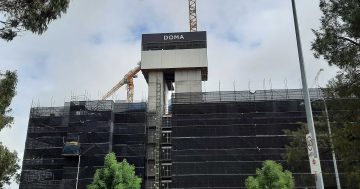
Minister for Building Quality Improvement Gordon Ramsay wants to break the link between developers and certifiers. Photo: Dominic Giannini.
Unit owners have welcomed moves for the return of public certifiers to improve building quality in the ACT, but say architects and engineers also need to be involved in project delivery from start to finish.
However, the ACT Property Council said the industry felt ambushed by Minister for Building Quality Improvement Gordon Ramsay’s announcement of plans to establish a team of public sector certifiers for large and complex projects as part of its reforms to restore confidence in the Territory’s construction sector.
Mr Ramsay said the new team would break the link between developers and the certifiers they use, and it would focus on multi-unit developments.
”With large and complex developments it’s the developer who is the owner and appoints the certifier,” he told the ABC. ”Clearly the risk is that the developers and the certifiers are too close.”
Mr Ramsay said legislated public certification for complex projects would complement moves to register developers and a new code of practice for building surveyors.
”With multi-unit developments, there are a lot of people who are affected if there is poor quality building,” Mr Ramsay said.
”It’s bad enough if you are the sole person living in a house and the building is poor quality but by the time it is affecting multiple people, that actually has a significant impact on the community.”
Owners Corporation Network ACT president Gary Petherbridge said Mr Ramsay was on the right track with public certifiers for multi-unit developments and developers having to be fit and proper persons to be in business, but architects and engineers should also have to be registered and involved in projects from the drafting of detailed plans to completion.
He said architects were often used to produce ”pretty pictures” for selling the projects and not retained throughout construction.
Mr Petherbridge, who began calling for a return to public certifiers a decade ago, said it was better late than never that Mr Ramsay now understood that multi-unit buildings were the issue.
”The developer isn’t going to be the owner when it finishes, there are going to be 600 owners, so they are the ones who need protection,” he said.
Mr Ramsay said the team would not be set up until after the election but work was continuing with the National Building Ministers Forum and National Construction Code to decide which buildings would require a public certifier.
For simple projects, people will have the choice of appointing a private or a public certifier, who will operate on a fee-for-service basis.
Mr Ramsay said that with construction to take a leading role in the post-COVID-19 economic recovery, it was important to get this right now.
”We think this is a very good time to be taking this next step to not only make sure that our building is of the highest quality but the confidence in the sector is the highest,” he said.
But the Property Council said it was disappointing to hear about such critical reforms via the media and accused Mr Ramsay of playing politics.

ACT executive director of the Property Council of Australia Adina Cirson said the industry was ambushed. Photo: File.
Property Council executive director Adina Cirson said the Council and other industry groups had been working collaboratively and constructively in the implementation of building reforms, both through the roll-out of the ACT Government’s 44 reforms, but also on the 24 recommendations made in the Shergold Weir Building Confidence report.
”We all want the very few in our industry doing the wrong thing to be held accountable,” she said. ”That’s why we support all of the reforms that the government has engaged us on.
”But not once has the government engaged with industry on the announcement made today in any of the forums in which we discuss the implementation of their reform program.
”It is disingenuous to say on one hand that you are cracking down on those doing the wrong thing, but on the other, have a Minister who refuses to engage and consult on measures which aren’t even on their own reform program.”
Master Builders ACT cautiously welcomed the ACT Government’s announcement but called for more detail about how the new system might work.
“The MBA has been calling for the implementation of building reforms in the ACT for more than a decade. Today’s announcement is a step in the right direction to improve building quality, provided the necessary consultation with industry experts and key stakeholders is undertaken,” Master Builders ACT CEO Michael Hopkins said.
“We understand consumers’ concerns about building quality and know that more must be done in order to improve building standards in Canberra.”
Mr Hopkins said private and public certifiers could work together, and this had been shown in other jurisdictions such as NSW, but the same standards must be applied to both to ensure consistency.
He called for more action to be taken on building quality including the implementation of the recommendations from the national Building Confidence report.
“Further steps to improve building confidence must be guided by the Building Confidence report and include requiring the registration of a broad range of building practitioners including engineers, designers, builders and site or project managers and that Continuing Professional Development training be mandated,” he said.
The ACT Greens called on the government to go further and expand the proposed scheme to go beyond large-scale residential developments, and that all buildings where the builder has been the subject of regulatory action should have to be assessed by a government building certifier.
The Liberal government of Kate Carnell scrapped public certification in the 1990s. There were predictions at the time that a privatised system would result in poor building practices.





















